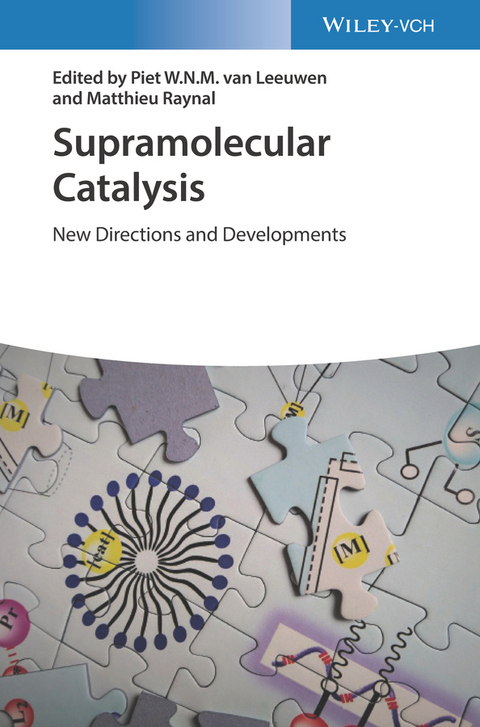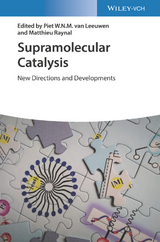Supramolecular Catalysis
Wiley-VCH (Verlag)
978-3-527-34902-9 (ISBN)
Piet van Leeuwen is holder of the "IDEX Chaire d´Attractivité", Université de Toulouse, INSA. He has chaired and directed many activities in the field of catalysis in the Netherlands. He worked with Shell in Amsterdam for twenty six years in a wide variety of topics of homogeneous catalysis. During many years he was in charge of Shell´s fundamental efforts related to organometallic chemistry and homogeneous catalysis. In 1989 he founded the homogeneous catalysis group at the University of Amsterdam, which he directed until 2007.His interest ranges from fundamental aspects to applied catalysis utilizing mainly late transition metals. New concepts to which he contributed include host-guest catalysis, dendrimer catalysis, effects of wide bite-angles, and in-situ spectroscopy. Main research areas are ligand effects in hydroformylation, carbonylation reactions, carbon-carbon bond formation reactions, microflow reactor systems for homogeneous catalysis, and e-learning. He has (co)authored more than 400 publications, about 35 patents, and is (co)author (co)editor of 9 books, of which stands out his popular textbook Homogeneous Catalysis; understanding the art. He has (co)supervised almost 50 PhD theses.Matthieu Raynal got his engineering diploma from ENSIACET (Toulouse) and then moved to Université de Strasbourg to get his PhD degree under the supervision of Dr Pierre Braunstein in 2009. He conducted postdoctoral studies at the Université Pierre et Marie Curie (UPMC, Paris, France) and in the group of Prof. Piet W. N. M. van Leeuwen at the Institute of Chemical Research of Catalonia (ICIQ, Tarragona, Spain). In 2012, he was appointed as a CNRS researcher in the group of L. Bouteiller (Sorbonne Université). He is fascinated by how non-covalent interactions can be designed to control the outcome of a catalytic reaction, i.e. supramolecular catalysis. His current interests concern the development of supramolecular helical catalysts with particular efforts devoted to exalt their chirality amplification and switchable properties, the design of functional chiral assemblies and the better understanding of the structure-property relationship of supramolecular polymers.
Preface
Introduction
LIGAND-LIGAND INTERACTIONS
Supramolecular Construction of Bidentate Ligands through Self-assembly by Hydrogen Bonding
Self-Assembled bidentate ligands in transition metal catalysis; from fundamental invention to commercial application
SELF-ASSEMBLED NANOSTRUCTURES AND MULTI-COMPONENT ASSEMBLIES
Assembled Ionic Molecular Catalysts and Ligands
Self-Amplification of Enantioselectivity in Asymmetric Catalysis by Supramolecular Recognition and Stereodynamics
Interlocked Molecules in Asymmetric Catalysis
Catalytic Supramolecular Gels
Supramolecular helical catalysts
Self-Assembled multi-component supramolecular catalysts for asymmetric reactions
LIGAND-SUBSTRATE INTERACTIONS
Harnessing non-covalent interactions for control of site-selectivity in transition metal-catalyzed C-H activation and cross-coupling
Supramolecular interactions in distal C-H activation of (hetero)arenes
Transition metal-catalyzed, site- and enantioselective oxygen and nitrogen transfer enabled by lactam hydrogen bonds
Supramolecular substrate orientation as strategy to control selectivity in transition metal catalysis
Phosphine Ligands with Acylguanidinium Groups as Substrate-directing Unit
Chemical reactions controlled by remote Zn...N interactions between substrates and catalysts
CATALYSIS PROMOTED BY DISCRETE CAGES, CAPSULES AND OTHER CONFINED ENVIRONMENTS
Artificial Enzymes Created Through Molecular Imprinting of Cross-Linked Micelles
Bioinspired catalysis using innately polarized Pd2L4 coordination cages
Supramolecular catalysis with a cubic coordination cage: contributions from cavity and external-surface binding
Transition metal catalysis in confined spaces
Catalysis by Metal Organic Cages: A Computational Perspective
N-heterocyclic carbene (NHC)-capped Cyclodextrins for cavity-controlled catalysis
Supramolecular Catalysis by Metallohosts Based on Glycoluril
Catalysis inside the hexameric resorcinare capsule: Towards addressing current challenges in synthetic organic chemistry
Supramolecular Organocatalysis Within the Nanospace of Resorcinarene Capsule
Resorcin[4]arene hexamer: from nanocontainer to nanocatalyst
SUPRAMOLECULAR ORGANOCATALYSIS AND NON-CLASSICAL INTERACTIONS
The Aryl-Pyrrolidine-tert-Leucine Motif as a New Privileged Chiral Scaffold: The Role of Non-Covalent Stabilizing Interactions
Chiral Triazole Foldamers in Enantioselective Anion-Binding Catalysis
Supramolecular Catalysis via Organic Solids: Templates to Mechanochemistry to Cascades
Exploration of halogen bonding for the catalysis of organic reactions
Chalcogen-Bonding Catalysis
Asymmetric Supramolecular Organocatalysis: the Fourth Pillar of Catalysis
SUPRAMOLECULAR CATALYSIS IN WATER
Metal Catalysis in Micellar Media
Surfactant assemblies as nanoreactors for organic transformations
Compartmentalized polymers for catalysis in aqueous media
Phosphines modified by cyclodextrins for supramolecular catalysis in water
Water-Soluble Yoctoliter Reaction Flasks
Chemical catalyst-promoted regioselective histone acylation
Protein-substrate supramolecular interactions for the shape selective hydroformylation of long chain a-olefins
Supramolecular assembly of DNA- and protein-based artificial metalloenzymes
SUPRAMOLECULAR ALLOSTERIC CATALYSTS AND REPLICATORS
Switchable Catalysis Using Allosteric Effects
Supramolecularly regulated enantioselective catalysts
Emergent catalysis by self-replicating molecules
| Erscheinungsdatum | 02.02.2022 |
|---|---|
| Verlagsort | Weinheim |
| Sprache | englisch |
| Maße | 170 x 244 mm |
| Gewicht | 1460 g |
| Themenwelt | Naturwissenschaften ► Chemie ► Physikalische Chemie |
| Schlagworte | catalysis • Chemie • Chemistry • Katalyse • Metallorganische Verbindungen • Organometallchemie • Organometallic Chemistry • Pharmaceutical & Medicinal Chemistry • Pharmazeutische u. Medizinische Chemie • supramolecular chemistry • Supramolekulare Chemie |
| ISBN-10 | 3-527-34902-2 / 3527349022 |
| ISBN-13 | 978-3-527-34902-9 / 9783527349029 |
| Zustand | Neuware |
| Informationen gemäß Produktsicherheitsverordnung (GPSR) | |
| Haben Sie eine Frage zum Produkt? |
aus dem Bereich




